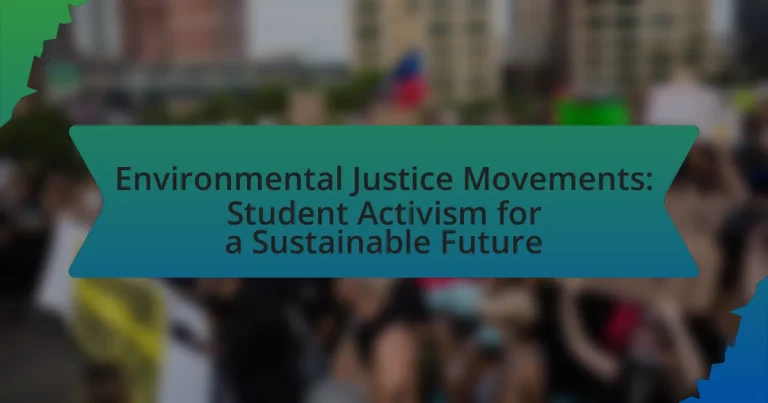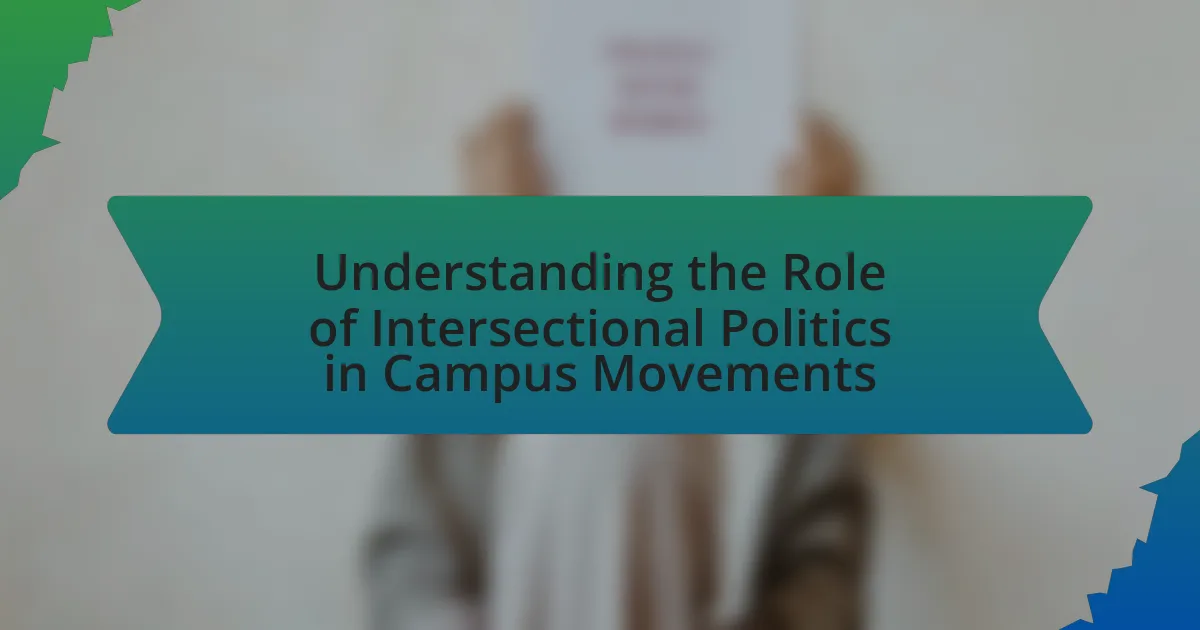Environmental Justice Movements are organized efforts aimed at addressing the unequal environmental burdens faced by marginalized communities, advocating for equitable access to environmental resources and protections. The article explores the relationship between these movements and student activism, highlighting the significant role students play in raising awareness, organizing protests, and influencing policy changes. Key historical events, such as the 1982 Warren County protests and the establishment of the environmental justice framework, are discussed, along with the principles that guide these movements. Additionally, the article examines the challenges student activists face, the strategies they employ, and the tangible outcomes of their efforts in promoting a sustainable future.
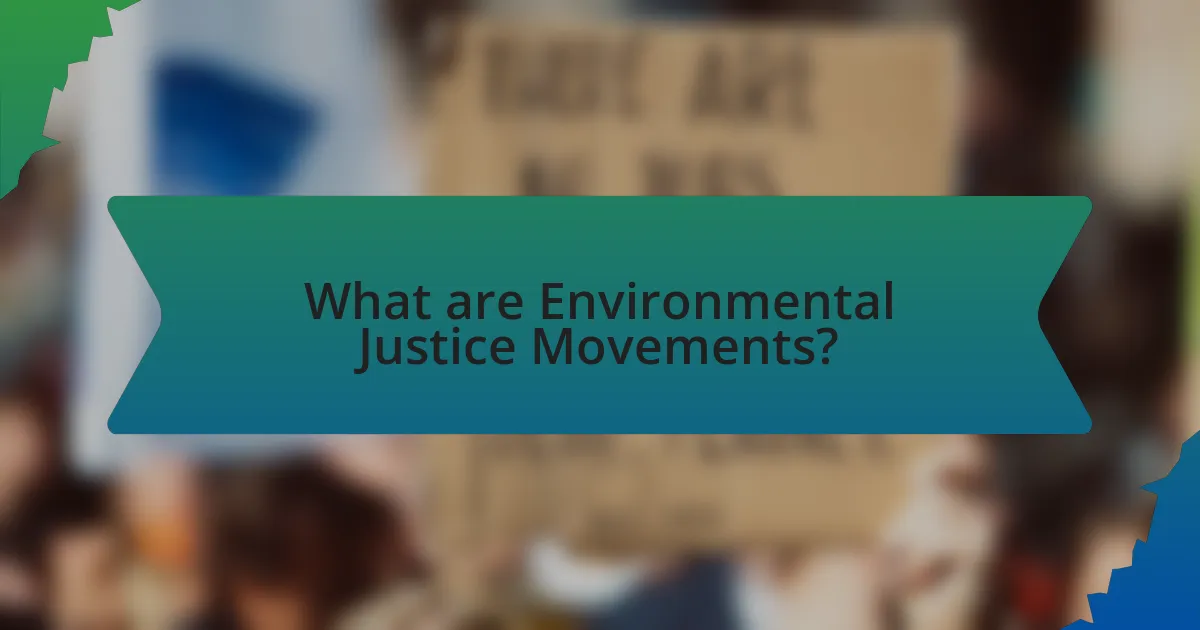
What are Environmental Justice Movements?
Environmental Justice Movements are organized efforts aimed at addressing the disproportionate environmental burdens faced by marginalized communities. These movements advocate for equitable distribution of environmental benefits and protections, emphasizing that all individuals, regardless of race, income, or social status, have the right to a healthy environment. Historical examples include the 1982 protests in Warren County, North Carolina, against the siting of a hazardous waste landfill in a predominantly African American community, which highlighted systemic inequities in environmental policy.
How do Environmental Justice Movements relate to student activism?
Environmental Justice Movements are closely related to student activism as students often serve as key advocates for environmental equity and sustainability. These movements highlight the disproportionate impact of environmental issues on marginalized communities, and students mobilize to raise awareness, organize protests, and influence policy changes. For instance, the Sunrise Movement, which includes many student activists, focuses on climate justice and has successfully pushed for the Green New Deal, demonstrating the significant role students play in advocating for systemic change in environmental policies.
What historical events have shaped Environmental Justice Movements?
Historical events that have shaped Environmental Justice Movements include the 1982 Warren County protests against hazardous waste landfills, which marked a significant turning point by highlighting the disproportionate impact of environmental hazards on marginalized communities. This event catalyzed the formation of the environmental justice framework, leading to the 1991 First National People of Color Environmental Leadership Summit, which established key principles for the movement. Additionally, the 1994 Executive Order 12898, signed by President Bill Clinton, directed federal agencies to address environmental justice in their policies, further institutionalizing the movement’s goals. These events collectively underscore the intersection of environmental issues with social justice, emphasizing the need for equitable treatment of all communities in environmental decision-making.
How do these movements address issues of inequality?
Environmental justice movements address issues of inequality by advocating for equitable access to environmental resources and protection for marginalized communities disproportionately affected by environmental hazards. These movements highlight the systemic disparities that exist, such as lower-income neighborhoods facing higher pollution levels and limited access to clean air and water. For instance, studies have shown that communities of color are often located near industrial sites, leading to increased health risks. By mobilizing student activism, these movements raise awareness, push for policy changes, and demand accountability from corporations and governments, thereby striving to rectify these injustices and promote sustainable practices that benefit all communities equally.
Why is Environmental Justice important for a sustainable future?
Environmental Justice is crucial for a sustainable future because it ensures equitable access to environmental resources and protection for all communities, particularly marginalized ones. This equity fosters social stability and community resilience, which are essential for sustainable development. Research indicates that communities facing environmental injustices often experience higher rates of health issues and economic disparities, undermining their ability to thrive sustainably. For instance, the U.S. Environmental Protection Agency reports that low-income and minority communities are disproportionately affected by pollution and climate change, highlighting the need for policies that address these inequities to promote a healthier, more sustainable environment for everyone.
What are the key principles of Environmental Justice?
The key principles of Environmental Justice include the fair treatment and meaningful involvement of all people, regardless of race, color, national origin, or income, in environmental decision-making processes. This principle emphasizes that no group should bear a disproportionate share of negative environmental consequences. Additionally, Environmental Justice advocates for the right to a healthy environment, equitable access to resources, and the protection of vulnerable communities from environmental hazards. These principles are supported by the recognition that systemic inequalities often lead to marginalized communities facing greater environmental risks, as highlighted in the 1991 Principles of Environmental Justice established at the First National People of Color Environmental Leadership Summit.
How does Environmental Justice impact marginalized communities?
Environmental Justice significantly impacts marginalized communities by addressing the disproportionate environmental burdens they face, such as pollution and lack of access to clean resources. These communities often experience higher exposure to hazardous waste, industrial pollution, and inadequate infrastructure, which can lead to health disparities and reduced quality of life. For instance, studies show that low-income neighborhoods and communities of color are more likely to be located near toxic waste sites, resulting in increased rates of respiratory illnesses and other health issues. By advocating for equitable policies and sustainable practices, Environmental Justice movements aim to empower these communities, ensuring they have a voice in decision-making processes that affect their environment and health.
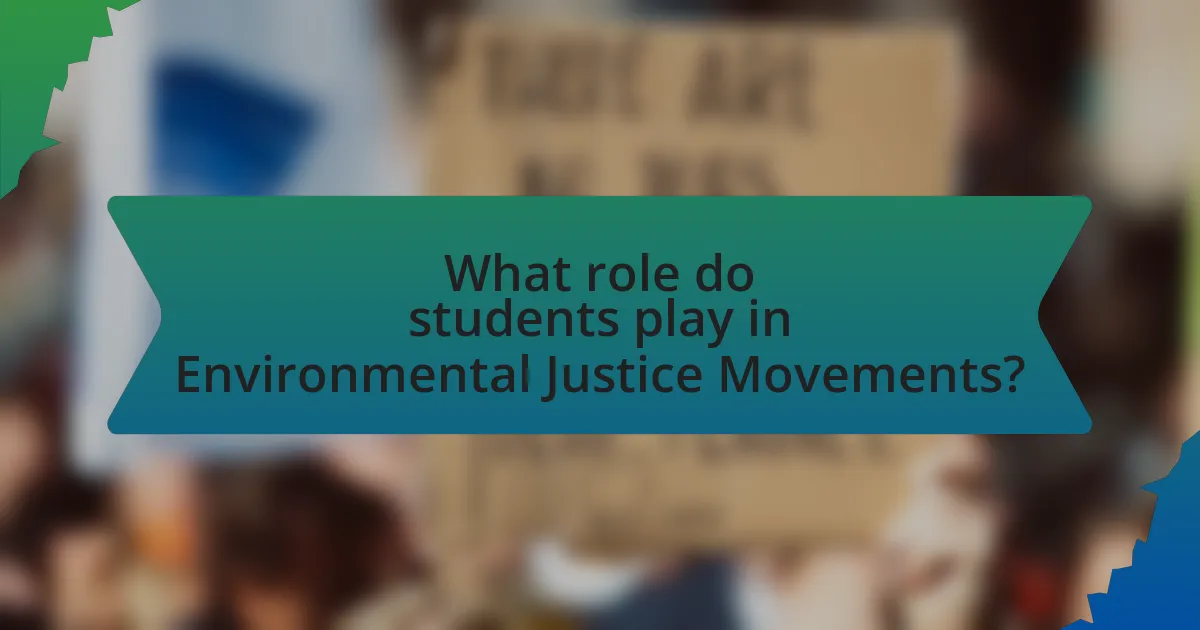
What role do students play in Environmental Justice Movements?
Students play a crucial role in Environmental Justice Movements by acting as advocates, organizers, and educators. They mobilize their peers and communities to raise awareness about environmental issues, particularly those affecting marginalized populations. For instance, student-led initiatives like the Sunrise Movement have successfully influenced policy discussions on climate change and social equity, demonstrating the power of youth activism. Additionally, research from the University of California, Berkeley, highlights that students often engage in protests, campaigns, and educational programs that emphasize the intersection of environmental and social justice, thereby amplifying the voices of those disproportionately impacted by environmental degradation.
How are students mobilizing for environmental causes?
Students are mobilizing for environmental causes through organized protests, social media campaigns, and participation in environmental clubs and initiatives. For instance, the global climate strikes, inspired by activists like Greta Thunberg, have seen millions of students participate in demonstrations to demand action on climate change. Additionally, platforms like Instagram and Twitter are utilized by students to raise awareness, share information, and organize events, amplifying their voices and reaching a wider audience. Research indicates that youth-led movements have significantly influenced policy discussions, as seen in the increased attention to climate issues in political agendas following student activism.
What strategies do student activists use to raise awareness?
Student activists use various strategies to raise awareness about environmental justice issues, including social media campaigns, organizing protests, and collaborating with local communities. Social media campaigns allow activists to reach a broad audience quickly, utilizing platforms like Instagram and Twitter to share information, mobilize support, and create viral content that highlights environmental concerns. Organizing protests and demonstrations serves to physically manifest their demands, drawing public attention and media coverage to specific issues, such as climate change or pollution. Collaborating with local communities enables student activists to engage directly with those affected by environmental injustices, fostering grassroots support and amplifying marginalized voices. These strategies have proven effective in raising awareness and influencing public opinion, as evidenced by the global impact of movements like Fridays for Future, which mobilized millions of students worldwide to advocate for climate action.
How do student-led initiatives influence policy changes?
Student-led initiatives influence policy changes by mobilizing collective action and raising awareness on critical issues, particularly in the realm of environmental justice. These initiatives often utilize social media platforms to amplify their messages, engage a broader audience, and pressure policymakers to address specific concerns. For instance, the student-led climate strikes initiated by Greta Thunberg in 2018 galvanized millions globally, leading to increased political discourse around climate policies and commitments from various governments to reduce carbon emissions. Research indicates that youth activism has a significant impact on public opinion and can sway legislative agendas, as seen in the adoption of more stringent environmental regulations in response to student advocacy.
What challenges do student activists face in their efforts?
Student activists face significant challenges in their efforts, including institutional resistance, lack of funding, and limited access to decision-makers. Institutional resistance often manifests as pushback from school administrations or local governments, which may view student activism as disruptive. Additionally, funding constraints hinder the ability to organize events, campaigns, and outreach initiatives, as many student groups operate on tight budgets with little financial support. Limited access to decision-makers further complicates their efforts, as students may struggle to engage with policymakers who hold the power to effect change. These challenges are documented in studies such as “Youth Activism in the 21st Century” by the Center for Information and Research on Civic Learning and Engagement, which highlights the barriers faced by young activists in mobilizing for social and environmental justice.
How do institutional barriers affect student activism?
Institutional barriers significantly hinder student activism by limiting access to resources, restricting freedom of expression, and imposing bureaucratic obstacles. For instance, universities may enforce policies that require prior approval for demonstrations, which can stifle spontaneous activism and discourage student participation. Additionally, financial constraints, such as lack of funding for student organizations, can impede the ability to mobilize and organize events effectively. Research indicates that institutions with stringent regulations on student activities often see lower levels of engagement in activism, as students feel disempowered and unsupported in their efforts to advocate for environmental justice.
What are the common misconceptions about student-led movements?
Common misconceptions about student-led movements include the belief that they lack seriousness and are merely a phase or trend. Critics often underestimate the commitment and organization involved in these movements, which are frequently driven by deep-seated concerns about social and environmental issues. For instance, the global climate strikes initiated by students, such as those led by Greta Thunberg, mobilized millions and demonstrated significant public engagement and awareness, contradicting the notion that student activism is trivial. Additionally, there is a misconception that student-led movements are solely reactive; in reality, they often involve proactive strategies and long-term planning aimed at achieving systemic change.
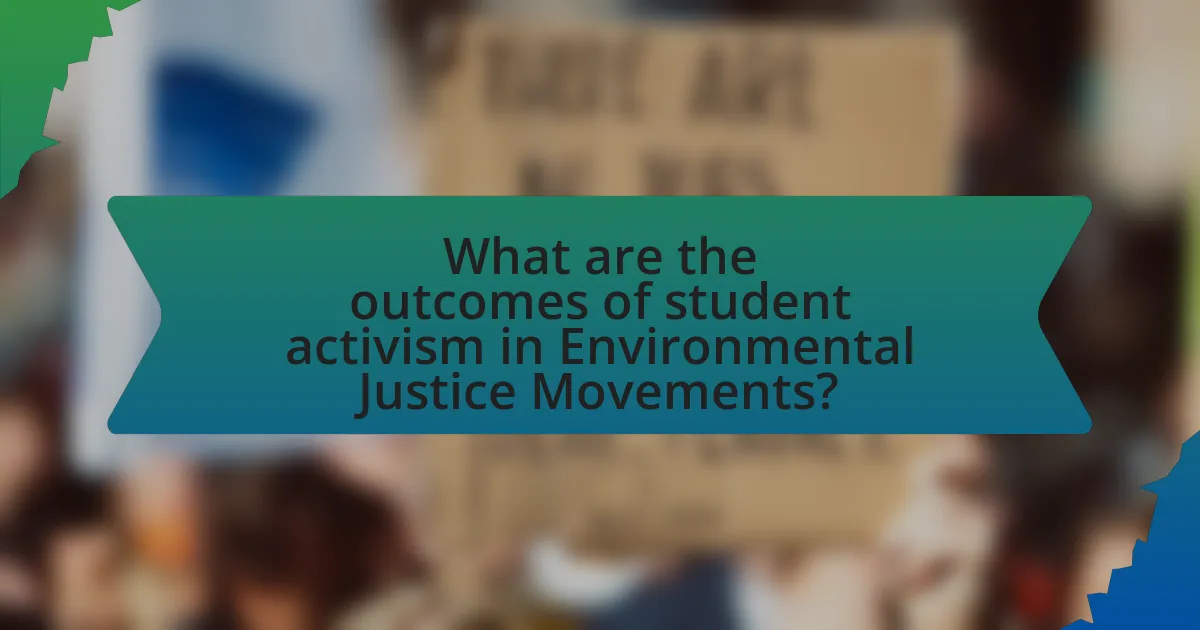
What are the outcomes of student activism in Environmental Justice Movements?
Student activism in Environmental Justice Movements leads to increased awareness, policy changes, and community engagement. For instance, student-led initiatives have successfully influenced local governments to adopt more sustainable practices, such as the implementation of renewable energy sources in schools. A notable example is the 2019 student-led climate strike, which mobilized millions globally and pressured policymakers to prioritize climate action, resulting in commitments from various governments to reduce carbon emissions. Additionally, research from the University of California found that student activism significantly enhances community involvement in environmental issues, fostering a culture of sustainability and social responsibility among peers.
How have student-led movements achieved tangible results?
Student-led movements have achieved tangible results by mobilizing collective action to influence policy changes and raise awareness about environmental issues. For instance, the Sunrise Movement, a youth-led organization, successfully advocated for the Green New Deal in the United States, which aims to address climate change and economic inequality. Their efforts included organizing protests, engaging in direct lobbying of lawmakers, and utilizing social media to amplify their message, resulting in increased public discourse and legislative proposals focused on sustainability. Additionally, the student-led March for Our Lives campaign has effectively pushed for gun control reforms, demonstrating how youth activism can lead to concrete legislative changes. These movements illustrate the power of organized youth activism in driving significant societal and political shifts.
What successful campaigns have been led by students?
Successful campaigns led by students include the March for Our Lives, which advocated for gun control following the Parkland shooting, and the Sunrise Movement, which focuses on climate change and the Green New Deal. The March for Our Lives mobilized over 800,000 participants in Washington, D.C., demonstrating significant youth engagement in policy change. The Sunrise Movement has successfully influenced political discourse around climate policy, leading to the introduction of the Green New Deal in Congress, showcasing the impact of student-led initiatives on national issues.
How do these outcomes contribute to a sustainable future?
Outcomes from environmental justice movements contribute to a sustainable future by promoting equitable resource distribution and advocating for policies that address climate change impacts on marginalized communities. These movements highlight the interconnectedness of social justice and environmental sustainability, ensuring that all communities have access to clean air, water, and safe living conditions. For instance, research indicates that inclusive environmental policies can lead to improved public health outcomes and reduced pollution levels, which are essential for long-term ecological balance. By mobilizing student activism, these movements foster a generation that prioritizes sustainability and equity, ultimately driving systemic change necessary for a resilient future.
What can students do to enhance their impact in Environmental Justice Movements?
Students can enhance their impact in Environmental Justice Movements by actively participating in community organizing and advocacy efforts. Engaging in local initiatives allows students to address specific environmental issues affecting marginalized communities, such as pollution and access to clean water. Research indicates that grassroots movements, which often involve student participation, can lead to significant policy changes; for example, the 2019 Sunrise Movement successfully mobilized youth to advocate for the Green New Deal, highlighting the power of collective action. Additionally, students can educate themselves and others about environmental justice issues through workshops and social media campaigns, thereby raising awareness and fostering a more informed community.
What resources are available for student activists?
Student activists have access to various resources that support their efforts in environmental justice movements. These resources include organizations such as the Sierra Club and Greenpeace, which provide training, funding, and networking opportunities. Additionally, universities often have sustainability offices that offer grants and mentorship programs for student-led initiatives. Research databases and online platforms like Change.org enable activists to mobilize support and disseminate information effectively. Furthermore, social media serves as a powerful tool for outreach and community building, allowing student activists to connect with like-minded individuals and organizations globally.
How can students collaborate with local communities for greater effect?
Students can collaborate with local communities for greater effect by engaging in joint projects that address environmental issues, such as community clean-ups or tree planting initiatives. This collaboration fosters mutual understanding and leverages local knowledge, enhancing the impact of environmental justice movements. For instance, a study by the National Environmental Education Foundation found that community-based projects involving students not only improve local ecosystems but also increase civic engagement and awareness among participants. By working together, students and communities can create sustainable solutions that benefit both the environment and the local population.
